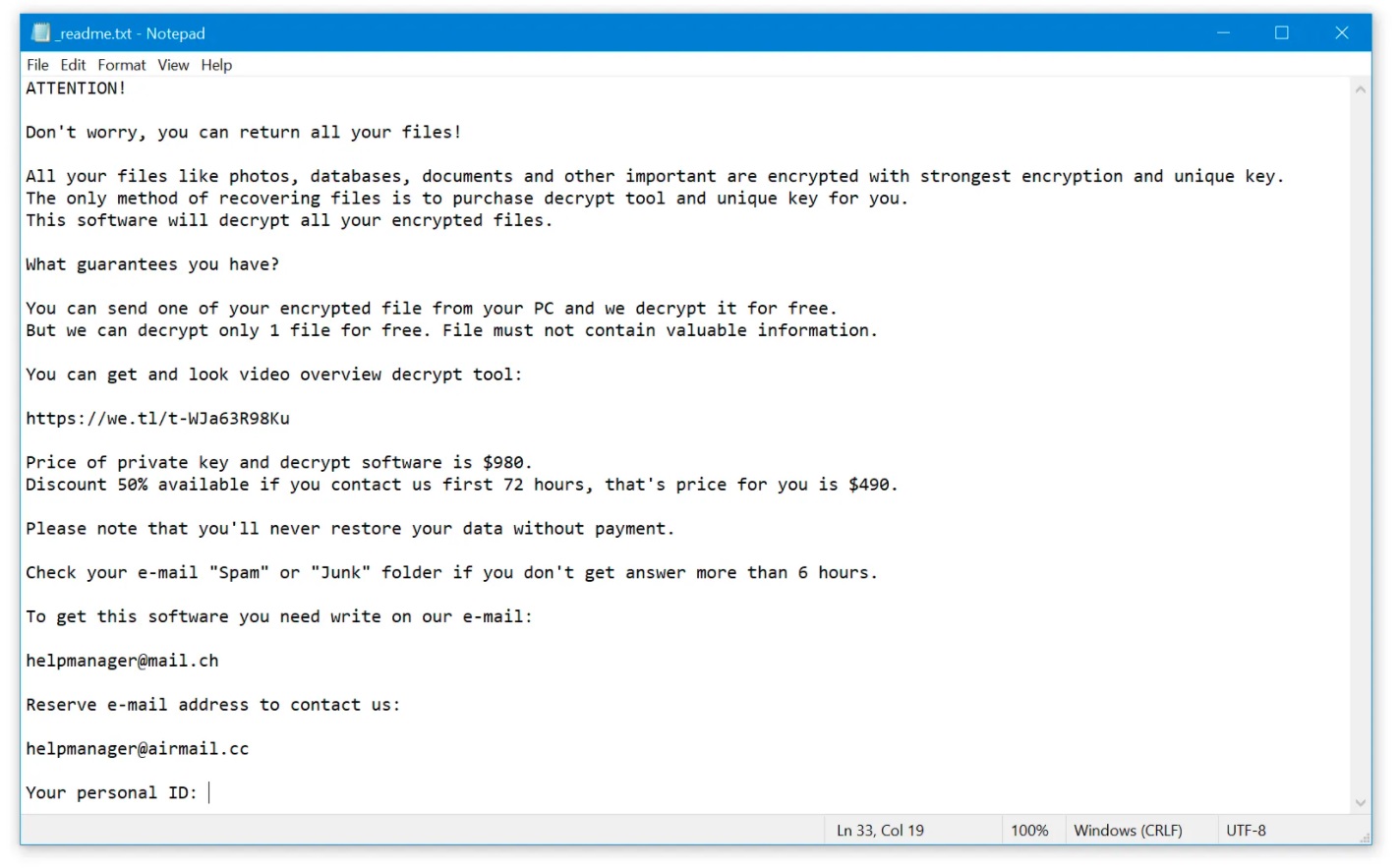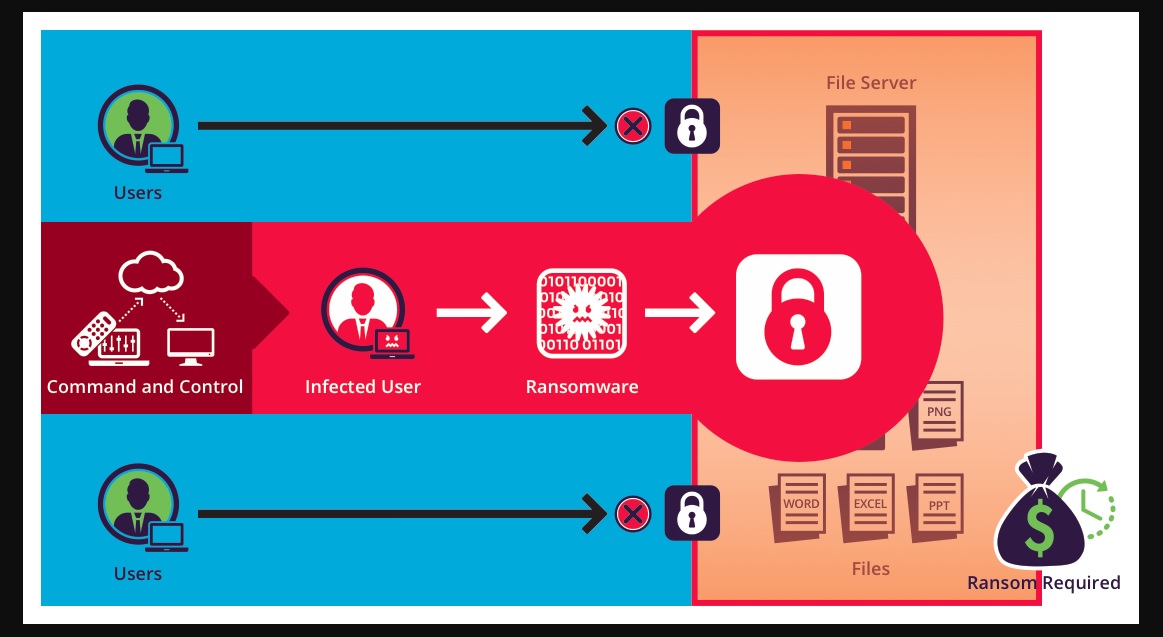Please, have in mind that SpyHunter offers a free 7-day Trial version with full functionality. Credit card is required, no charge upfront.
| Virus Name | ccps |
| Type of threat | Ransomware, cryptovirus, file-locking virus |
| File Extension | .ccps |
| Encryption type | RSA 2048 + Salsa20 |
| Ransom Note | _readme.txt |
| Amount of Ransom | $980 ($490 – 50% discount for payment within 72 hours) |
| Contact | helpteam@mail.ch, helpmanager@airmail.cc |
| Genealogy | DJVU Ransomware |
| Detections |
BitDefender: Trojan.GenericKD.43898764; ESET-NOD32: Win32/Filecoder.STOP.A McAfee Packed-GCU!CD876A27DAFE, more detections VirusTotal |
| Distribution | Spam email attachments, RDP, pirated software, torrent websites, phishing sites |
| Removal Tool |
In order to completely remove ransomware from your computer, you will need to install an antivirus software. We recommend using SpyHunter |
| Recovery Tool |
The only effectvie method to restore files is to copy them from a saved backup. If you don’t have a suitable backup, you may use third-party recover software such as iBeesoft Data Recovery |
How to Remove .Ccps File Extension Ransomware?
Sspq ransomware is a dangerous ransomware virus that poses serious threats to the security of your computer. It is one of several new DJVU ransomware variants. It encrypts all types of files, including images, audio, video, documents, archives, database, and others. The infection procedure begins by launching malicious processes in Task Manager so that the malware itself goes unnoticed by the victim. Once a victim has been infected by ransomware, they’re locked out of their files until they pay the ransom. However, it is definitely not the best option as they might steal your money and leave you without anything. We recommend using our guide to remove Sspq Ransomware and decrypt.sspq files.

The message of the ransom note states something like this:
ATTENTION! Don't worry, you can return all your files! All your files like photos, databases, documents and other important are encrypted with strongest encryption and unique key. The only method of recovering files is to purchase decrypt tool and unique key for you. This software will decrypt all your encrypted files. What guarantees you have? You can send one of your encrypted file from your PC and we decrypt it for free. But we can decrypt only 1 file for free. File must not contain valuable information. You can get and look video overview decrypt tool: https://we.tl/t-WJa63R98Ku Price of private key and decrypt software is $980. Discount 50% available if you contact us first 72 hours, that's price for you is $490. Please note that you'll never restore your data without payment. Check your e-mail "Spam" or "Junk" folder if you don't get answer more than 6 hours. To get this software you need write on our e-mail: helpteam@mail.ch Reserve e-mail address to contact us: helpmanager@airmail.cc Your personal ID: XXXXXXXXXXXXXXXXXXXXXXXXXXXXXXX
How did I get infected with?
The shortest answer is that you accidentally clicked something you shouldn’t click. Ccps infections are caused by careless behavior. They send phishing messages disguised as legitimate ones and prompt people to click links or download files. They can also resort to the old, but gold, invasive methods, like free software and fake bogus updates. You might think you’re updating Java, but you’d actually be opening up a security hole. Beware of everything you click! The internet is full of dangers, and cyber attacks lurk everywhere. Before agreeing to any terms and conditions, check out the spam filter and install software from vetted websites. Do your research before making any decisions. Ransomware attacks are often spread using social engineering. A hacker or a group of hackers sends millions of emails to people on the internet, hoping that a few will click on the infected attachment or link. You may also come across malware lurking on torrent sites, fake software updates and pornography websites.

Why is .Ccps File Extension dangerous?
Ransomware is particularly dangerous for two reasons:
- First, it encrypts your data and locks them away behind strong password protection.
- Second, the hackers behind ransomware may not unlock your files even after you pay the ransom.
Avoid opening email attachments from unknown sources. Ransomware typically gets onto your computer when you open a Word attachment that contains malicious Visual Basic code or a PDF file with an embedded exploit. Once the ransomware encrypts your data, you face a choice. The criminals behind ransomware will email you a password that unlocks your data. The problem is, if you pay the ransom, there is no guarantee that they will actually unlock your data or provide the password. In some cases, the cybercriminals will take your money but not unlock your files.
Do not pay for Sspq!
Please, try to use the available backups, or Decrypter tools
.Ccps File Extension Removal Instructions
Please, have in mind that SpyHunter offers a free 7-day Trial version with full functionality. Credit card is required, no charge upfront.
STEP 1: Kill the Malicious Process
STEP 3: Locate Startup Location
STEP 4: Recover .Ccps File Extension Encrypted Files
STEP 1: Stop the malicious process using Windows Task Manager
- Open your task Manager by pressing CTRL+SHIFT+ESC keys simultaneously
- Locate the process of the ransomware. Have in mind that this is usually a random generated file.
- Before you kill the process, type the name on a text document for later reference.

- Locate any suspicious processes associated with .Ccps File Extension encryption Virus.
- Right click on the process
- Open File Location
- End Process
- Delete the directories with the suspicious files.
- Have in mind that the process can be hiding and very difficult to detect
STEP 2: Reveal Hidden Files
- Open any folder
- Click on “Organize” button
- Choose “Folder and Search Options”
- Select the “View” tab
- Select “Show hidden files and folders” option
- Uncheck “Hide protected operating system files”
- Click “Apply” and “OK” button
STEP 3: Locate .Ccps File Extension encryption Virus startup location
- Once the operating system loads press simultaneously the Windows Logo Button and the R key.
- A dialog box should open. Type “Regedit”
- WARNING! be very careful when editing the Microsoft Windows Registry as this may render the system broken.
Depending on your OS (x86 or x64) navigate to:
[HKEY_CURRENT_USER\Software\Microsoft\Windows\CurrentVersion\Run] or
[HKEY_LOCAL_MACHINE\SOFTWARE\Microsoft\Windows\CurrentVersion\Run] or
[HKEY_LOCAL_MACHINE\SOFTWARE\Wow6432Node\Microsoft\Windows\CurrentVersion\Run]
- and delete the display Name: [RANDOM]

- Then open your explorer and navigate to:
Navigate to your %appdata% folder and delete the executable.
You can alternatively use your msconfig windows program to double check the execution point of the virus. Please, have in mind that the names in your machine might be different as they might be generated randomly, that’s why you should run any professional scanner to identify malicious files.
STEP 4: How to recover encrypted files?
- Method 1: The first and best method is to restore your data from a recent backup, in case that you have one.

- Method 2: File Recovery Software – Usually when the ransomware encrypts a file it first makes a copy of it, encrypts the copy, and then deletes the original. Due to this you may try to use file recovery software to recover some of your original files.
- Method 3: Shadow Volume Copies – As a last resort, you can try to restore your files via Shadow Volume Copies. Open the Shadow Explorer part of the package and choose the Drive you want to recover. Right click on any file you want to restore and click Export on it.


